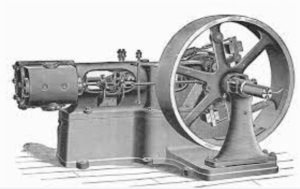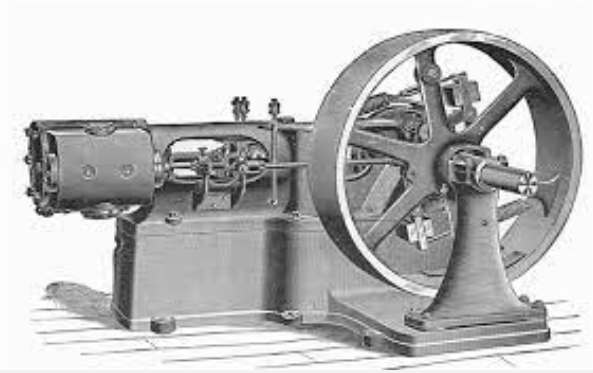 The Machinery Industry is a sector that constantly develops with the historical development of humanity and creates the main lines of production by bringing innovations that can be considered revolutionary. Starting from ancient times, especially with the transition of humanity to collective life, human power has gradually left its place for industrial machines. The rapid growth and development in the field of industry from the past to the present have brought about mechanization and the development of machines.
The Machinery Industry is a sector that constantly develops with the historical development of humanity and creates the main lines of production by bringing innovations that can be considered revolutionary. Starting from ancient times, especially with the transition of humanity to collective life, human power has gradually left its place for industrial machines. The rapid growth and development in the field of industry from the past to the present have brought about mechanization and the development of machines.
Even though industrial and technological developments vary accordingly to the development levels of the countries of the world, the related development spread into the world’s industries rapidly from the first day they emerged. This movement, which was a historical turning point, emerged in England in the 18th century, especially during the time when the industrial revolution took place, is considered the beginning of the transition from production based on human and animal power to production with machines.
Sectoral Research and Development (R&D) organizations entered a rapid cycle with the industrial revolution. As a result of the industrial revolution led by England in the 1780s, 54 important inventions were made, and the first step of industrialization started with the invention of the steam engine in the 18th century.
Industrial Revolution and Mechanisation Process
The industrial revolution has gone through historical developments such as the first, second, third and fourth industrial revolutions. As the industrial revolution created the small industry movement, especially the production of iron, steel and textile accelerated with the introduction of machinery in this period. The popularization of the railway network also took place during this period.
The end of the 19th century and the beginning of the 20th century is known as the second industrial revolution. The prominent concept of this period is the concept of technology. As the sciences developed, machines also became more technologically advanced. The combine harvester in 1839, the sewing machine in 1844, and the canning and packaging machines in the mid-1880s are among the machines invented in this period.
This period, also known as the Third Industrial Revolution or the Modern Industrial Revolution, is the period between the 1970s and 1990s. The Lever Shears, which is one of the most important inventions of this period, was invented in 1978. A transformation to a period in which the importance of machines is increasing day by day and computers have become a part of life begins.
The development in technology has enabled the computerized and electronic production and use of machines. Labour rates were reduced and mechanization increased in order to reduce costs.
The Fourth Industrial Revolution is the period which has lasted until the period we are in and is known as Industry 4.0. During this period, concepts such as artificial intelligence and 3D printer technology have been introduced to our lives and everything that is being produced is produced with the help of fully-automated machines and computers, without the help of human power. The development of construction equipment started in the 1800s.
Historical Development of the Machines Used in the Industry
The machines used in the industry sector are used for manufacturing and production. Historically, the period of mechanization started with the industrial revolution and continued up to this day as the first, second, third, and fourth industrial revolutions. During this period, the concept of innovation also gained importance.
Some of the machines that were invented during the first industrial revolution are as follows;
- The seed planting machine was invented in 1701.
- In 1775, the steam engine, which was a great technological product of the time, began to be used.
- The automatic weaving machine was invented in 1785.
- The threshing machine was invented in 1793.
- The first sewing machine was invented in 1851.
At the beginning of the industrial revolution, the machines invented were first designed to be used in the agriculture and textile industries and they contributed to the development of these industries significantly.
Some of the machines that were invented during the second industrial revolution are as follows;
- Steam-operated machines were developed.
- Inventions were made in the field of yarn production and weaving. A few of them are flying shuttles and mechanical weaving.
- The machines used in electricity were also being used in the industry.
Development of the machines during the third industrial revolution is as follows;
- Computers, micro-electronic, and fiber optic lasers were invented in the field of technology.
- Developments were made in the fields of telecommunication, nuclear energy, biotechnology, and agricultural biotechnology.
As a result of the fourth industrial revolution, facilities and factories which can make products without the help of human power, via artificial intelligence originated.
Milestones of Mechanisation
There are some points in history which are considered milestones in the historical development process of mechanization. Historically, these milestones are as follows;
- The invention of the steam-operated machine in 1763 is the first milestone and also the beginning of the industrial revolution. Therefore, this period is also called Industry 1.0.
- The development in the machinery industry thanks to the production of iron and steel affected the period between the end of the 1800s and 1970, therefore the Industry 2.0 period emerged.
- The period between the years 1970 and 1990 is also known as Industry 3.0. During this period, analogue systems transformed into digital systems.
- The period starting from the year 1991 and last to the present is called Industry 4.0. During this period, machines such as the Laser Cutting Machine has been constructed to become computerized and artificial intelligence-aided. Thus, the importance of human power decreased significantly.
Historical Development of the Machines Used in the Production
Giving information about the historical development of some important machines used in production will clarify the subject and provide a better idea. The historical developments of the machines mentioned above are as follows:
The press brake is a type of press machine used to bend metal sheet plates. The first press brakes were used as a simple manual press in the 1800s.
Since the first presses were very difficult to use and required labour, the development of press brakes accelerated with the development of hydraulic systems in the 1920s.
Towards the end of the 1960s, computer-operated press brakes originated. These machines enabled the precision and speed of the process to increase. Today, press brakes are produced in many different sizes and features and they are used in the metal processing industry commonly.
Punch machines are used for cutting and shaping materials. Punch is indeed an original name. These machines appeared as simple technological products in the past. After the manual punching process was complete, motor-operated punching processes were carried out. Today, using computer technology, fully automated punchings can be performed.
Shears, also known as the guillotine shears, is a system that has been used since the 1700s. The shears, which were operated manually in the beginning, then started to be used with hydraulic systems. Later, it was transformed into a computerized system and today, it has been computerized and artificial intelligence-aided with CNC technology.
Generally used for industrial production, a laser cutting machine is a preferred technology for cutting iron, bimetal, aluminium, stainless, and similar metal materials. This machine, which was first produced and utilized by Durmazlar Makina in 2017, is one of the best examples to be given of advanced technology machines.
The laser power source is a resonator that has the capacity to cut materials such as stainless steel, aluminium, copper and brass up to 30 kW and is also produced by Durmazlar Makina for the first time in Turkey.
What the Future Has In Store for the Machinery Industry?
The concept of Industry 5.0, which has been used since 2017, has begun to shape life. In a sense, we started to experience this concept with the introduction of technologies, which do not contain the human factor, into our lives. We have started to get familiar with concepts such as full automation or production without touching. These technological developments have turned into a system in which all machines are integrated and managed by artificial intelligence.
With the development of technology, a system where employees will be robots and people can manage technology from their homes or places is not far away anymore.
You can visit our websites (https://www.durmaonline.com / https://www.durmazlar.com.tr ) and read our other published blog articles.



